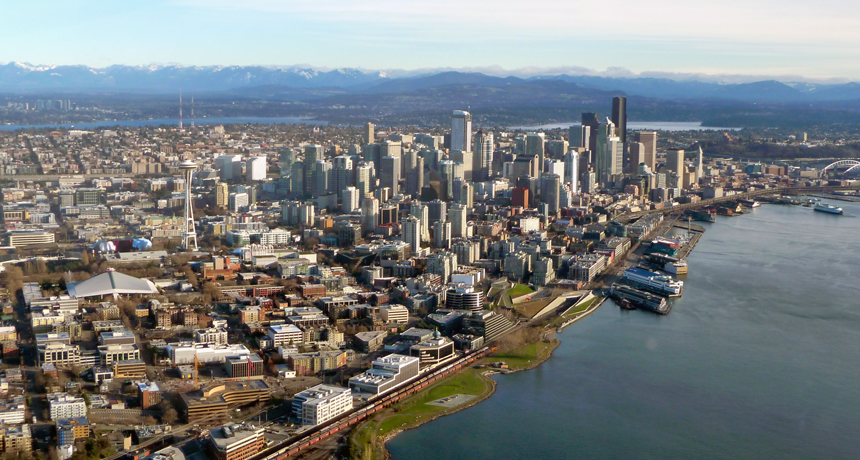Mapping our carbon footprints
Living in cities is good for the planet. Living near cities, not so much

People living in big cities — like Seattle, Wash., (shown here) — tend to have smaller carbon footprints than do those who dwell in suburbs, a new study finds.
Ian Maddox/Wikimedia Commons
How densely packed your neighborhood is can affect the health of our planet, a new study finds.
Scientists measured the impact that people have on the environment using a “yardstick” that they call a carbon “footprint.” That footprint reflects the amount of carbon dioxide — a greenhouse gas — that is spewed into the atmosphere as a result of someone’s daily activities. Carbon footprints tend to be low for city dwellers. Living in a suburb outside a city, however, can turn that footprint into a bootprint.
Energy researchers Christopher Jones and Daniel Kammen published their findings Dec. 13 in Environmental Science and Technology.
The scientists, both at the University of California, Berkeley, calculated carbon footprints for people in every zip code across the United States. To do that, they summed up how much energy and other resources went into providing each person with their transportation, food and housing. Jones and Kammen also looked at items people would typically buy and the amount of water people used.
People living in city centers had small footprints, the researchers found. “It is much easier to have a low carbon impact if your family’s home is close to where you work, shop and play,” explains Jones. Living within walking or biking distance cuts back on the amount of carbon dioxide associated with moving people by cars. And cities with extensive bus and subway networks allow people to travel great distances while keeping releases of climate-altering greenhouse gases low.
Not everyone can afford to live in the city, however. And not everyone wants to. Rings of suburbs have popped up around major cities across the world. Suburbs offer more space, allowing people to build larger homes. Suburbs may offer better schools for a family’s kids. But those homes are typically well beyond walking distance from where their owners work, play or learn. So people who live in suburbs often drive long distances. There’s also the matter of heating and cooling big homes.
All of these factors can bump up carbon footprints so that they exceed those of city dwellers, Jones and Kammen report. The difference is substantial. The average household in a large city releases about 40 tons of carbon dioxide per year. The average suburban household, however, releases closer to 50 tons of carbon dioxide per year. That’s a 25 percent increase over city dwellers.
The new findings are an important contribution to climate research, says Matthew Kahn. An environmental economist at the University of California, Los Angeles, he was not involved with the study. Kahn would like to see the analysis applied to other parts of the world — Europe, India and China, for instance. That would give scientists a better feel for how culture might mix with location to influence our carbon footprints.
You may not have any control over the location of your home. Still, everyone can take steps to shrink their carbon footprints, says Jones. That’s because how much we pollute is influenced not just by where we live, but also how we live.
To shrink your footprint, start small, he says. Turn off lights when they’re not in use. Recycle or reuse things instead of throwing them away. These might not seem like steps that will have a big impact. And as people get used to making small changes, the leap to bigger ones will get easier. Also avoid buying things you don’t need. After all, the process of making new items also produces more pollution, explains Jones.
Power Words
atmosphere The envelope of gases surrounding Earth or another planet.
carbon dioxide A gas produced by all animals when the oxygen they inhale reacts with the carbon-rich foods that they’ve eaten. This colorless, odorless gas also is released when organic matter (including fossil fuels like oil or gas) is burned. Carbon dioxide acts as a greenhouse gas, trapping heat in Earth’s atmosphere. Plants convert carbon dioxide into oxygen during photosynthesis, the process they use to make their own food.
carbon footprint The amount of carbon dioxide released into the air as a result of daily human activities. The footprint includes direct emissions such as those from a car’s tailpipe. It also includes carbon dioxide released during the manufacture of items purchased or used in the home (including electricity, fuel and building materials).
environmental economist Someone who studies the financial value of things in the environment (including clean water and dirty air, for instance), and how human activities (such as transportation use or purchases) can have an effect on the environment and the use of natural resources.
greenhouse gas A gas that contributes to the greenhouse effect by absorbing heat. Carbon dioxide is one example of a greenhouse gas.







